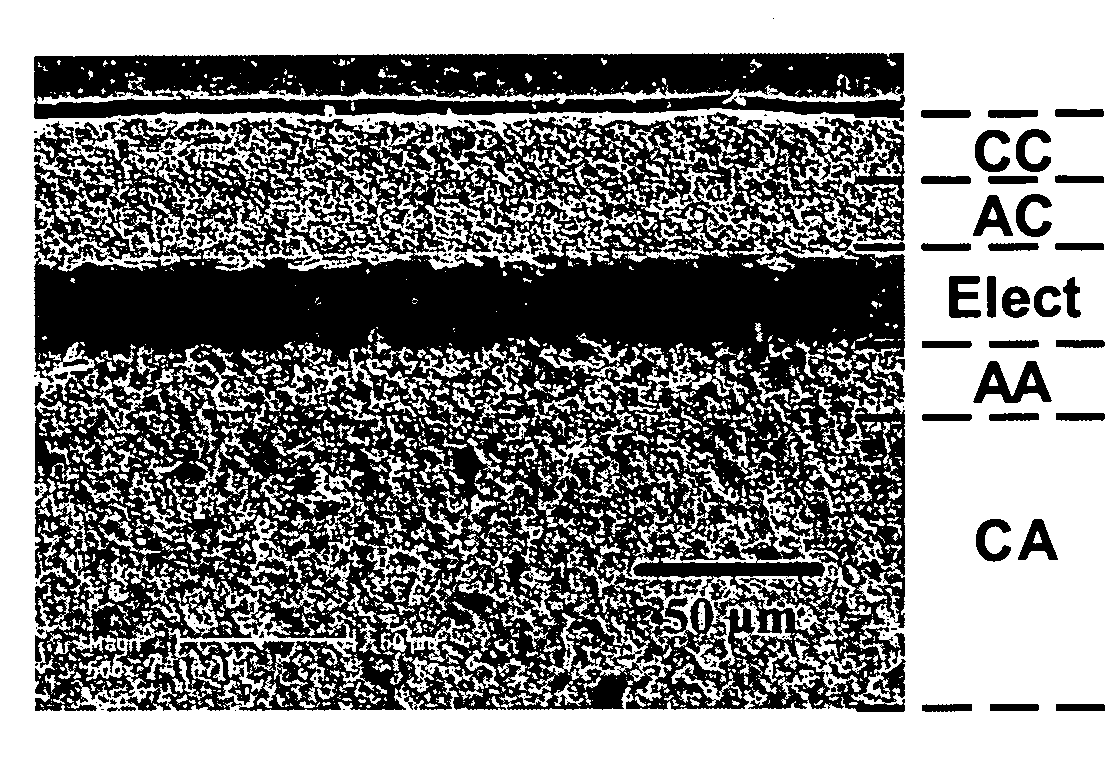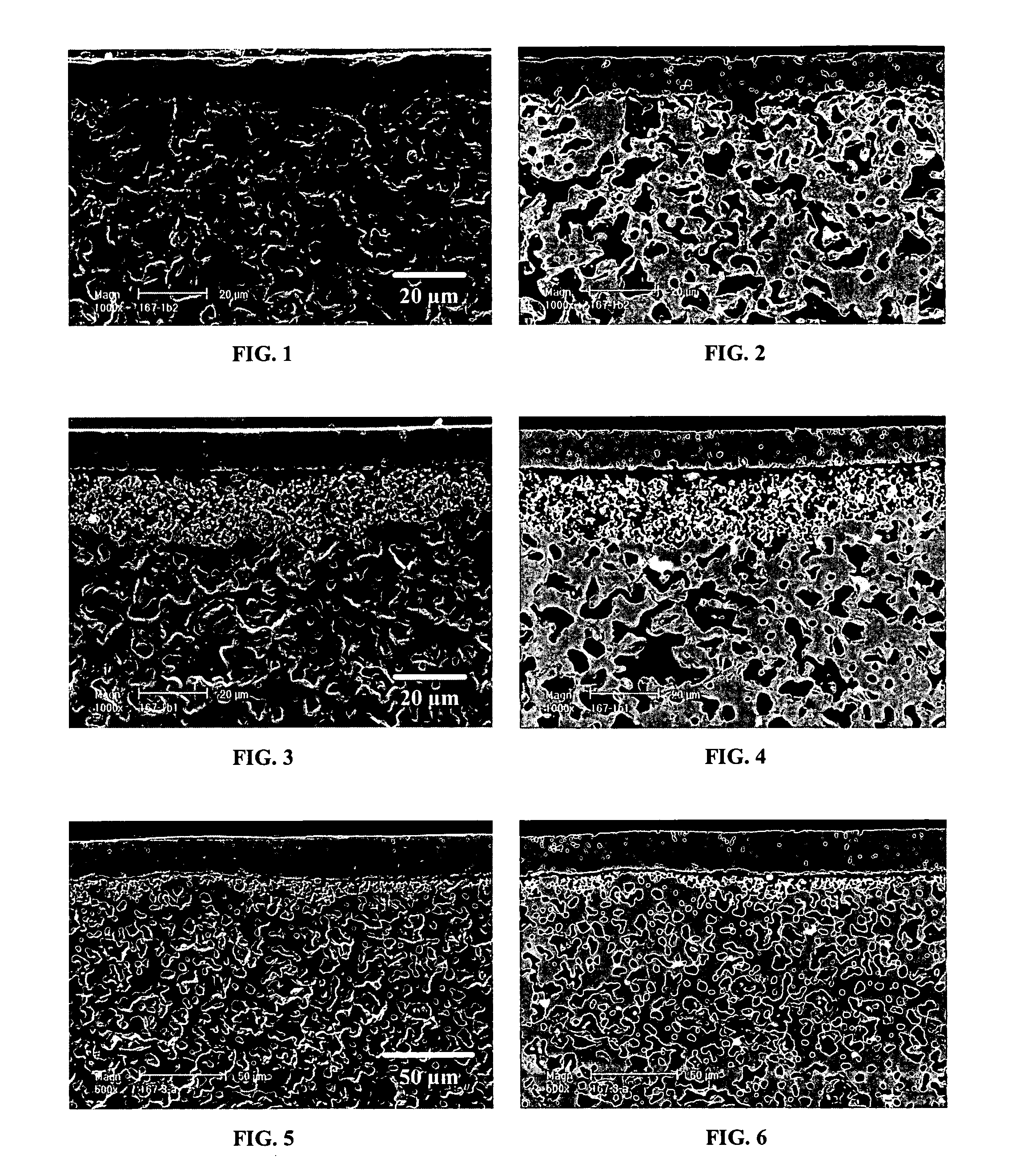Nonazeotropic terpineol-based spray suspensions for the deposition of electrolytes and electrodes and electrochemical cells including the same
a technology of terpineol and spray suspension, which is applied in the field of spray suspension, can solve the problems of high installation cost, high cost of evd process, and inability to meet cost targets for mass-market applications,
- Summary
- Abstract
- Description
- Claims
- Application Information
AI Technical Summary
Benefits of technology
Problems solved by technology
Method used
Image
Examples
example 1
Preparation of Electrolyte Spray Suspension
[0058]In a 1 liter Nalgene bottle, 250 ml of 1 cm diameter zirconia media and 100 ml of acetone were added to 2.25 g Hypermer KD-1 dispersant. This material was placed on a vibratory mill for 10 minutes to completely dissolve the dispersant. To this solution, 150 g Daiichi ZrO2-6 mol % Sc2O3-1 mol % Al2O3 powder was added. The resultant slurry was returned to the vibratory mill for 24 hours to assure complete deagglomeration of the powder. The slurry was poured into a 1 liter Pyrex beaker and the solvent allowed to evaporate at 60° C. until half the initial volume of the slurry was reached. To this mixture, 80.85 g terpineol-based screen-printing vehicle (Johnson Matthey 63 / 2, medium grade) was added and stirring continued. When the slurry was again homogenized, the slow evaporation at 60° C. was resumed and continued until the specific gravity of the suspension reached 1.3 g / cm3. Small amounts of terpineol, a terpineol-based solvent or bin...
example 2
Preparation of Electrode Spray Suspension
[0059]In a 1 liter Nalgene bottle, 250 ml of 1 cm diameter zirconia media and 100 ml of acetone were added to 0.41 g Hypermer KD-1 dispersant. This material was placed on a vibratory mill for 10 minutes to completely dissolve the dispersant. To this solution, ˜125 g of cathode or anode composite powder was added. The resultant slurry was returned to the vibratory mill for 24 hours to assure complete deagglomeration of the powder. The slurry was poured into a Pyrex pan and the solvent allowed to evaporate in a convection oven held at 60° C. until dried. The powder was then sieved through a 60 mesh screen. 50 g powder was slowly added to 15 g terpineol-based screen printing vehicle (Johnson Matthey 63 / 2 medium) using an ultrasonic wand. The slurry was ultrasonicated for 15 minutes. Small amounts of terpineol, a terpineol-based solvent or binder system, or the majority solvent may be added to the prepared suspension as needed to reduce the suspe...
example 3
Electrolyte Deposition on Cathode Substrate
[0060]A coating of the electrolyte spray suspension was applied to a previously sintered lanthanum manganite-based cathode tube using a small airbrush. The electrolyte suspension as applied at a thickness sufficient to produce a coating 15 μm thick and then sintered at 1300° C. for one hour.
[0061]The resultant microstructure is shown in FIGS. 1 and 2. As can be seen in the micrographs, penetration of the film into the substrate was minimal due to the relatively high viscosity of the suspension.
PUM
| Property | Measurement | Unit |
|---|---|---|
| thickness | aaaaa | aaaaa |
| temperatures | aaaaa | aaaaa |
| diameter | aaaaa | aaaaa |
Abstract
Description
Claims
Application Information
 Login to View More
Login to View More - R&D Engineer
- R&D Manager
- IP Professional
- Industry Leading Data Capabilities
- Powerful AI technology
- Patent DNA Extraction
Browse by: Latest US Patents, China's latest patents, Technical Efficacy Thesaurus, Application Domain, Technology Topic, Popular Technical Reports.
© 2024 PatSnap. All rights reserved.Legal|Privacy policy|Modern Slavery Act Transparency Statement|Sitemap|About US| Contact US: help@patsnap.com










